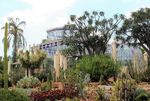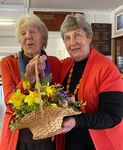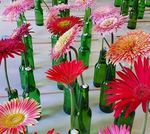What they said on Facebook - Highlands Garden Society
←
→
Page content transcription
If your browser does not render page correctly, please read the page content below
ABN 74 058 867744
www.gardenclubs.org.au
‘Friendship through Gardens’
Secretaries: Please email this directly to your committee & members.
What they said on Facebook…
Coffs Harbour Garden Club - NSW
At the very first meeting since February of Coffs
Harbour Garden Club, we were very proud for
Simon Young to receive the Ann Williams Clark
Award.
Since joining the club in 2012 he has been
extremely active in a variety of important roles for
the club, demonstrating a strong willingness to
serve and also a desire to see the club grow and
change in a positive way. Simon's contribution has
been an important element in the development
and on-going success of our club.
Congratulations Simon.
Club President Margaret Hunt makes the award - socially distanced of course!
Twin Towns & District Garden Club - Gwendoline Barnes
Twin Towns & District Garden Club have not been able to
visit any of the Open Gardens planned so it was decided
by Committee to let the members see some gardens of
the Club's own members in the Tweed Shire and beyond.
One of the gardens recently visited by our President
Lesley was Meyril's.
Her home is situated on the high side of Old Ferry Rd
Meyril’s house is completely hidden from view as it sits in
the middle of her own private, expansive rainforest.
When visiting, it is hard to believe that you are in a built-
up area, not a National Park! No neighbour's, no roads,
just trees!
Meyril acquired the property in 1990. At that time, it was
a wilderness of weeds, vines, fish fern, blady grass,
stinking rogers and overgrown paths.
Since that time, she has devoted all her time and energy
into creating the amazing landscape we see today.
The land had to be cleared, paths and retaining walls
built, (mainly from thousands of recycled materials) and
thousands of rainforest plants established. There is the steep driveway leading to the house, and Meyril is
often seen picking freesias that pop up between a border of various bromeliads and agaves.
Little paths and larger tracks join the different levels in a most interesting way. There is something new to
look at every turn. At the end of lawn, another surprise: a special “garden room” which was one of Lesley's
favourites. Such a lovely place to escape for a bit of quiet time.Ipswich Horticultural Society – Sandra Logue Qld
The show bench for Ipswich Horticultural Society was just so
pretty and the veggie display magnificent.
Patrick and his huge Gerbera won best miscellaneous cut
flower and best exhibit and Helen's Camellia won best cut
flower.
Helen scooped raffle prizes x2 and our Co-Patron, Jim
Madden, donated the hamper.
Carol Kerkin was a great speaker on perennial plants for our
climate.
Braidwood Garden Club -
Jennie Marston NSW
Braidwood Garden Club had its first meeting in several months last week.
Over the winter months we always plan indoor activities. Those who
attended had great fun assembling insect hotels that had been pre-cut by
one of our wonderful members, Brian James. We hope the hotels will
encourage insects, particularly native bees, into our gardens.
John Tuckwell, president: “We recently had our 40th birthday celebration with
50 people in attendance, including the founding president and a
representative from every decade sharing stories of the club.”
Wanneroo and Northern Suburbs Community Garden Inc. –
Roberta Dinnie WA
What a day!!!!! How amazing does it
feel to finally see our little project succeed. This is the vision of
what we saw in our minds so long ago. We have made it. And
getting better each week. Thank you to all who joined in today and
days passed. I feel so proud of all we have sacrificed to get this far.
Blood sweat and tears. Woooooo hoooo.
Nyngan Garden Club – Mary Burley NSW
Nyngan Garden Club held their postponed July meeting, in the
lovely garden of Margaret Gudgeons. (Pictured below right) The
10-year anniversary celebration will be celebrated towards the end
of the year.
The Graduates’ Garden Club
Inc. – Carmen Sablatnig NSW
The Graduates’ Garden Club Inc. in Sydney recently celebrated its 30th
Anniversary with a special lunch at the “Sous Le Soleil” French Restaurant
in Roseville Park with 20 members attending. Due to COVID 19 restrictions
our number was limited. A couple of happy snaps of the occasion!Goondiwindi and District Garden Club – Helen Dimond QLD
Over 60 visitors and members of The Goondiwindi and District Garden
Club enjoyed visiting Stan and Nyrie Wardle’s incredibly inspirational
garden on Sunday, 19th July. A superb winter day helped bring the crowd
out, and we all enjoyed seeing the abundance of native trees and shrubs
on display, and Stan’s wonderful sculptures. Stan and Nyrie’s garden
could be described as a grandchild’s paradise! Our president Gloria Cory
and also our local gardening guru Bernie Paesler addressed the
gathering. We are so lucky to have Bernie as a member of our club! As
Bernie stressed, it is all in the soil preparation, and Stan’s garden
certainly demonstrates that fact. Many thanks indeed to Stan and Nyrie
Wardle for opening their garden for our enjoyment.
Wellington Garden Group – NSW (Photo below left)
Wellington Garden Group
resumed meetings this
morning. A lovely winter
morning was enjoyed by our members for the annual Swap Day.
Maryborough Garden Club – Suzanne Bushell QLD
Maryborough Garden Club is one of the lucky ones, as life is
almost back to normal. Garden sticky beaks and art activities,
gossip and good food always make the twice-monthly outings
lots of fun. This fish skeleton activity was fun! (Photo below)
Coal River Valley Garden Club – Julie
Westthorp
Coal River Valley Garden Club in Richmond
Tasmania will be having their first
meeting/AGM since February this evening.
It will be so lovely to catch up with members after all this time.
Walcha Garden Club – Mary Brearly
Walcha Garden Club gathered for its first meeting since March at Walcha
Golf Club. Congratulating long time member Col on her recent 90th
birthday is newly elected President Diane Bazely. (Photo left)
Nyngan Garden Club – Mary
Burley (again)
Nyngan Garden Club, had another
enjoyable day, for its August
meeting. Lyn Hodge was host for
the day. We had a lovely lunch in
Lyn’s lovely garden, we also had a
feathered friend join us. (Can you
spot him in the photos?)
(Photo right)GCA Facebook!
Below are the links to the three GCA Facebook groups. You can share your stories from your club or your
garden on them.
Community Gardens https://www.facebook.com/groups/810519969464289
Club Activities https://www.facebook.com/groups/2249602565338673
Gossip https://www.facebook.com/groups/562479981146811
The GCA 2021 “Beautiful Gardens of Australia”
Calendar order form is attached to this email.
(Another image from this year’s calendar right)
Downward Facing Thorns
Rose experts love to tell you that roses don’t have thorns, they have prickles. Thorns are extensions of a
branch whilst prickles are a modification of the outer layer of a stem, prickles are detachable, and thorns
aren’t! And therefore, my lemon tree has thorns, but my roses don’t (pictured below). But all the same so
many quotes have been written about roses having thorns that we still like to call them thorns, out of
earshot of the rose experts and botanists.
I have been catching up on my
reading and came across an
interesting fact in an American
Rose Magazine that rose thorns
usually point downwards. So, I ran
out to the garden to check and
whilst some seemed to point
straight out from the branch, most
of them did indeed point
downwards. And this has some
very interesting implications.
How many times have you got your clothing caught on rose bushes? My usual reflex action when I get
caught is to pull upwards to become unstuck. I now see that if I actually pull the fabric down instead of up
it comes easily off the thorn undamaged. I hope this tip helps some of you gardeners who have told me
stories of how you have had to strip off layers of clothing just to get
out of a rose bed!
Also, when we are pruning or deadheading roses if you approach
the rose from above you will rarely get stuck on a thorn. When
removing your arm from a rosebush do so in a downward and
outward direction. And always remember to wear gloves which
protect the back of your hands because if you are weeding under
the rose bushes you want to avoid all of those downward facing
thorns. Also, try to pull your weeds out towards you rather than
pulling upwards.
http://nsw.rose.org.au/illawarra-region.html May ‘20 edition
Conversation Starters
Here’s an idea to get you started from the GCA “Ideas for club activities” booklet.Recycling vs Waste
• Tip/waste station vs home - differences, when
to use each form.
• Composting – types, how to, benefits.
• How to build these areas in one’s garden.
• Worm Farms - how they function and what is
the benefit to garden plants.
• Does your local waste station sell garden
products e.g. compost, mulch?
• Recycling items such as old pots, bricks, logs
etc.
Tips and tricks
Tips from ‘Companion Planting in Australia’ by
Brenda Little.
Rosemary. The name comes from the latin ‘ros
marinus’ – which means ‘dew of the sea’ and for the
life of me I can’t see how this shrubby, aromatic
plant earned it. Certainly it grows well near the sea
but it is also found in the Sahara desert.
The active principle in rosemary is its aromatic
volatile oil. Its use ranges from culinary to medical to beauty care. In the garden it earns its way by repelling
mosquitos, and being a friendly comparnion to sage, both stimulating the herb’s growth and strengthening
its taste. Rosemary and potatoes do not grow well near each other.
If you are making a separate herb garden, a rosemary hedge kept well-trimmed, makes a good border. It also
makes a protective edging to the cabbage plot, as cabbage worm butterflies don’t like it.
Our Gardens Magazine
Spring is in the air and our lovely magazine Our Gardens should have been
delivered to your door by now. There are some fabulous gardens and
parks including a profile of Cruden Farm, at Langwarrin, 40 kms from
Melbourne. The Witch’s Cauldron is an intriguing tale from far north
Queensland full of ferns and fire pits. We hunt for a sea change at the
Hunts sea change garden at Coffs Harbour.
Greenacres Community Garden shows us what Adelaide has to offer. The
tree church garden in Tumbarumba is open for business and a rescue story
in Central West NSW precedes a chat about gardening in a highland
climate at Gairloch Garden.
There is so much more as well, with tips, tricks and comments. Enjoy the
read!
Don’t forget, too, if you want to put a small piece about your club’s activities into the In Touch section of
the next (summer issue) of Our Gardens, you need to send 100-150 words and one or two captioned
pictures to carolyn.dawes@bigpond.com by 1st September
“Townsville, Beautiful One Day, Perfect the Next”
Convention 12th – 16th September ‘21Convention convenor, Shirly Haslem assures us the plans for an exciting convention week are on schedule,
with ten guest speakers locked in covering topics from cordylines to syntropic agriculture.
Registration commences in October ’20.
Environmental Officer, Brandan Espe will showcase the gardens at the James Cook University.
Also, we’ll take a visit to the 17-hectare
Palmetum Botanical Garden which displays
one of the largest and most diverse public
collections of palms in the world. Guest
speaker Helen Paulsen one of the original
designers of the Palmetum in 1988, will join us.
Syntropic agriculture, you ask?
Neil and Jane Hawes live in Tolga on the
Tablelands and Neil will be a guest speaker at
the convention on syntropic agriculture.
Syntropic agriculture is based on the teachings
of Ernst Gotsch, a Swiss-Brazilian who over the last 30 years has developed a method of farming that
produces an abundance of agricultural crops and regenerates degraded ecosystems.
Syntropic Farming is an innovative approach to regenerative agriculture which allows us to create dynamic,
successional, and economically viable ecosystems that restore degraded soil biodiversity. By understanding
and respecting nature's complex system, Syntropic Farming imitates the natural regeneration of forests
and provides a harmonious integration of our food production systems.
Syntropic farming is a system that produces its own organic matter through the practice of pruning, which
continually increases resources while boosting root activity and encouraging a higher rate of
photosynthesis. The results are abundant systems which produce healthy soils and profitable harvests,
sequester carbon, regenerate the ecosystem and do not require long term external inputs.
There are five principles to work with.
1. Ground Cover
2. Maximising Photosynthesis
3. Natural Succession
4. Stratification
5. Management
Through these principles, we can also implement small or large scale reforestation, land restoration,
regenerative food production and even regenerative timber systems, all while moving towards abundance.
https://syntropicfarms.com.au/
National Gardening Week
Don’t forget National Gardening Week is just around the corner – October 11-17!
You can Dig In & Celebrate your passion for gardening in a hundred different ways!
Details on the GCA website https://gardenclubs.org.au/national-gardening-week or
contact George Hoad Ph: 0265505890 E: ghoad@internode.on.net
Kind Regards
Suzanne Bushell
(Communication)
0439 882 684
communications@gardenclubs.org.auYou can also read



























































